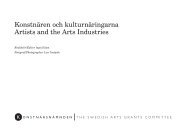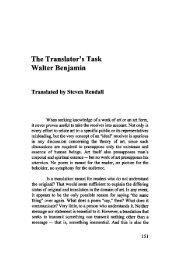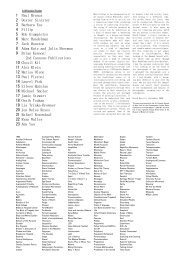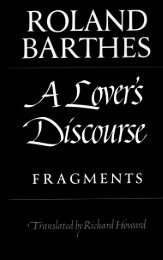Damien Hirst the Excellent Painter - Harald Peter Ström
Damien Hirst the Excellent Painter - Harald Peter Ström
Damien Hirst the Excellent Painter - Harald Peter Ström
You also want an ePaper? Increase the reach of your titles
YUMPU automatically turns print PDFs into web optimized ePapers that Google loves.
The resolution of a spiritual journey, <strong>the</strong> cosmic in <strong>the</strong> mundane<br />
<strong>Hirst</strong> has already declared an agenda of "going more towards Rembrandt and away from<br />
Bacon". Rembrandt is noted for his integration of darkness and light. At <strong>the</strong> end of <strong>the</strong><br />
show, <strong>Hirst</strong>'s Requiem, White Roses and Butterflies (25, 20), celebrates <strong>the</strong> grail attained at<br />
<strong>the</strong> end of a spiritual odyssey. The continuation of <strong>the</strong> colours of dark blue and white relate<br />
<strong>the</strong> painting to <strong>the</strong> rest of <strong>the</strong> exhibition. The starting motif of <strong>the</strong> skull has been<br />
transubstantiated into a spray of white roses in a vase, which takes its place alongside<br />
settled outlines of a glass of liquid and a cigarette packet on a table top. The constellation<br />
of butterflies across <strong>the</strong> dark depths of <strong>the</strong> background creates <strong>the</strong> effect of a star-filled<br />
sky, or <strong>the</strong> emanative force at <strong>the</strong> creation of <strong>the</strong> universe. It is a visual equivalent to<br />
Blake's "Auguries of Innocence":<br />
To see a World in a Grain of Sand<br />
And a Heaven in a Wild Flower,<br />
Hold Infinity in <strong>the</strong> palm of your hand<br />
And Eternity in an hour.<br />
After <strong>the</strong> bleak purgatorial journey and <strong>the</strong> dark night of <strong>the</strong> soul, where everything nonessential<br />
was stripped away and inhuman power was confronted face to face, it is a<br />
celebration of joy, beauty and wonder, a spiritual healing and illumination. The requiem is<br />
for <strong>the</strong> death of death.<br />
<strong>Hirst</strong>'s previous conceptual oeuvre stands in contrast to this work as a series of studies for<br />
it - literally <strong>the</strong> concepts which now inform his paintings, where <strong>the</strong> infinitely more subtle<br />
and flexible capability of paint is able to bring his meaning into fruition with a previously<br />
unachievable clarity and force of expression. In order to do this, he has on <strong>the</strong> whole wisely<br />
recognised as a painter his limitations, within which he has defined and mastered <strong>the</strong><br />
approaches and motifs necessary to realise a highly focused vision. This is not <strong>the</strong> end of<br />
<strong>the</strong> journey, or even <strong>the</strong> map for it, but ra<strong>the</strong>r a first step from one stage of personal and<br />
artistic life to <strong>the</strong> next. As an initial body of paintings it is an outstanding achievement.<br />
The numbering in <strong>the</strong> book "No Love Lost" differs for most paintings from <strong>the</strong> show numbering.<br />
The numbers in brackets show <strong>the</strong> book number first and <strong>the</strong> show number second.<br />
See also:<br />
<strong>Damien</strong> <strong>Hirst</strong> and <strong>the</strong> Reactionary Critics









